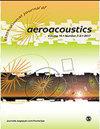高速列车简化车头产生的气动噪声研究
IF 1.3
4区 工程技术
Q3 ACOUSTICS
引用次数: 0
摘要
采用涡旋声理论和声学类比方法,研究了高速列车经过简化车头和车头比例模型时的气动噪声特性。对几何形状周围的非定常流场进行了数值求解,并将所得数据应用于近场四极声源的研究和远场辐射噪声的计算。研究发现,前导车周围的紊流以多尺度的几何分离涡为特征。体积偶极子源的强度远大于体积四极子源,体积偶极子源成为近场四极噪声的主要来源。在车头、转向架、转向架空腔和车头尾部等区域,气流明显分离,在这些区域,固体表面产生的压力波动很大,相应地产生高水平的偶极子噪声。通过比较,前导转向架和转向架腔的噪声贡献大于其他部件的噪声贡献。此外,列车前车厢模型的数值和实验结果表明,转向架周围的流动是主要的气动声源。因此,在一定的频率范围和特定的方向上,通过减小前导转向架和转向架空腔周围的流动相互作用,可以有效地降低前导车厢产生的流致噪声。本文章由计算机程序翻译,如有差异,请以英文原文为准。
Investigation on aerodynamic noise generated from the simplified high-speed train leading cars
The aerodynamic noise behavior of flow passing the simplified leading car and nose car scale models of a high-speed train is investigated through the vortex sound theory and acoustic analogy approach. The unsteady flow developed around the geometries is solved numerically and the data are applied to study the near-field quadrupole sound source and calculate the far-field noise radiated. It is found that the turbulent flow developed around the leading car is characterized by multi-scale vortices separated from the geometries. The intensity of volume dipole source is much larger than that of volume quadrupole source and the volume dipole source becomes the predominate source of the near-field quadrupole noise. The flow is separated noticeably in the regions of the nose, bogies, bogie cavities, and train tail of the leading car where the pressure fluctuations are generated largely upon the solid surfaces and correspondingly a dipole noise of high level is produced. By comparison, the noise contribution from the leading bogie and bogie cavity is larger than that from the other components. Moreover, the numerical and experimental results of train nose car model demonstrate that the flow around the bogie region is the dominant aerodynamic sound source. Therefore, the flow-induced noise generated from the leading cars may be reduced efficiently within a certain frequency range and specific direction by mitigating the flow interactions around the areas of leading bogie and bogie cavity.
求助全文
通过发布文献求助,成功后即可免费获取论文全文。
去求助
来源期刊

International Journal of Aeroacoustics
ACOUSTICS-ENGINEERING, AEROSPACE
CiteScore
2.10
自引率
10.00%
发文量
38
审稿时长
>12 weeks
期刊介绍:
International Journal of Aeroacoustics is a peer-reviewed journal publishing developments in all areas of fundamental and applied aeroacoustics. Fundamental topics include advances in understanding aeroacoustics phenomena; applied topics include all aspects of civil and military aircraft, automobile and high speed train aeroacoustics, and the impact of acoustics on structures. As well as original contributions, state of the art reviews and surveys will be published.
Subtopics include, among others, jet mixing noise; screech tones; broadband shock associated noise and methods for suppression; the near-ground acoustic environment of Short Take-Off and Vertical Landing (STOVL) aircraft; weapons bay aeroacoustics, cavity acoustics, closed-loop feedback control of aeroacoustic phenomena; computational aeroacoustics including high fidelity numerical simulations, and analytical acoustics.
 求助内容:
求助内容: 应助结果提醒方式:
应助结果提醒方式:


